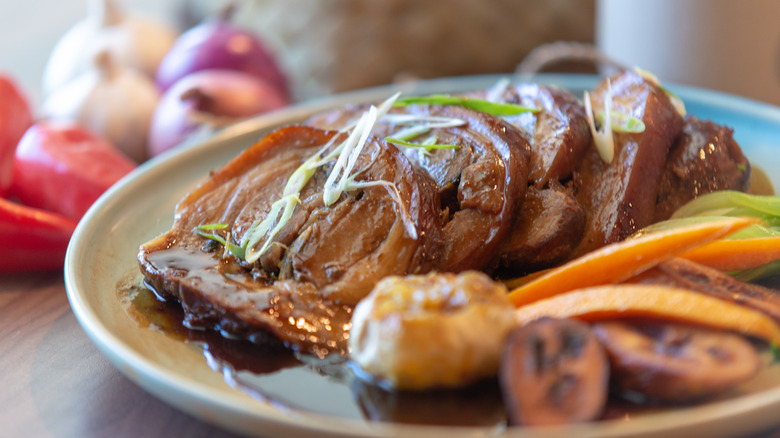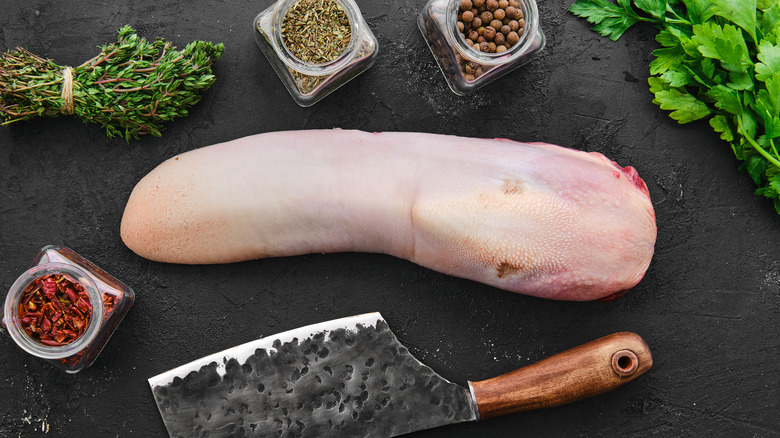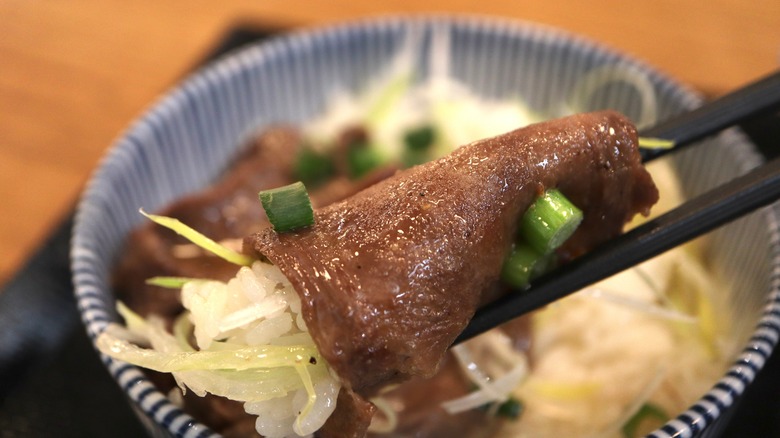Tongue Meat Is A Delicacy. Here's What You Need To Know To Cook It
Eating tongue meat may not be what you're used to, but there's a reason it's regarded as a delicacy globally. Whether that's duck, moose, lamb, beef, ox, pig, or even llama, the tongue is enjoyed in a variety of ways for its texture and meaty flavor. Within the United States, you'll likely find beef tongue most commonly available, and for that reason, this article will focus on what you need to know to enjoy this version.
Beef tongue has a gamey flavor that's imbued with fatty notes, and its texture simply melts in your mouth once it's cooked. By its appearance, cooking this cut may leave you scratching your head, wondering how to prepare it. Is there a unique tool for cooking tongue meat? Not at all; it's relatively straightforward. You can easily boil, grill, braise, bake, or pickle beef tongue.
Beef tongue can be chewy and tough if cooked incorrectly, so it's integral to remember to cook the tongue slowly on low heat. Ideally, you want to tenderize the meat first, making it much easier to remove the tongue's firm outer layer. When prepared correctly, tongue meat's texture can resemble that of butter. How can one possibly resist?
Preparing tongue meat
There are three ways to optimize the texture of tongue meat. You can either braise, boil, or put the tongue meat in a slow cooker. Indeed, these methods can also be used in combination with one another. It's also paramount to peel away the tough outer layer of skin to uncover the ideal texture, as this exterior is rough, coarse, and pretty difficult to eat.
Boiling the tongue meat allows you to easily remove the harder exterior skin, while braising allows the tongue to soak up all the wonderful flavors from the aromatics, spices, and braising liquids (such as wine or stock). On the other hand, preparing beef tongue in the slow cooker is ideal for convenience, so it needs only a salt rub and aromatics before being placed into the cooker to tenderize to perfection. A common method for preparing tongue meat involves boiling it first before searing it in a pan or on the grill. This renders the fat and produces a gorgeously crispy, golden crust.
Tongue meat can sometimes have a hard piece of cartilage found near the rear of the cut, and you will want to remove this. This can be easy to remove once the tongue has had time to boil or braise.
A delicious and tender delicacy
Beef tongue is eaten as a delicacy throughout South America and Southeast Asia, and exploring some of these dishes might inspire how you intend to prepare yours.
Tongue meat tacos, or tacos de lengua, is a classic Mexican dish that combines melting pieces of braised beef tongue within a soft, warm tortilla. The braise includes onion, garlic cloves, bay leaves, peppercorns, and beef stock to produce a taco that's moist, succulent, and irresistibly rich. Some fantastic joints in LA offer this take on beef tongue in burritos if you want to taste it before you attempt to prepare it yourself.
Over the Pacific in Sendai, Japan, is gyutan. This version of beef tongue meat uses only the softest parts of the tongue meat (the middle and root). These are sliced and cooked on a charcoal grill. Preparing gyutan does not include boiling, braising, or slow cooking, but the genius is in the way the thin cuts and citrusy sauce tenderize the otherwise tough meat instead. While there's some debate about marinating meat in citrus and the timing involved, gyutan avoids this dilemma by incorporating the sauce upon serving. Try braised beef with smoked beets for a balanced meal that's full of umami and balanced flavors.
If you were curious about tongue meat, it's time to shake off any hesitation. It's a delectable cut of meat that you've undoubtedly overlooked until now.


